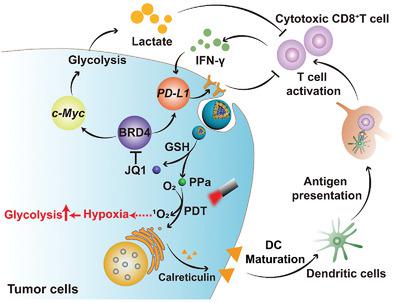Our official English website, www.x-mol.net, welcomes your
feedback! (Note: you will need to create a separate account there.)
Regulating Glucose Metabolism with Prodrug Nanoparticles for Promoting Photoimmunotherapy of Pancreatic Cancer
Advanced Science ( IF 14.3 ) Pub Date : 2021-01-04 , DOI: 10.1002/advs.202002746 Fang Sun 1, 2 , Qiurong Zhu 2 , Tianliang Li 2 , Madiha Saeed 2 , Zhiai Xu 3 , Feisheng Zhong 2 , Rundi Song 2 , Manxiu Huai 1 , Mingyue Zheng 2 , Cen Xie 2 , Leiming Xu 1 , Haijun Yu 2, 4
Advanced Science ( IF 14.3 ) Pub Date : 2021-01-04 , DOI: 10.1002/advs.202002746 Fang Sun 1, 2 , Qiurong Zhu 2 , Tianliang Li 2 , Madiha Saeed 2 , Zhiai Xu 3 , Feisheng Zhong 2 , Rundi Song 2 , Manxiu Huai 1 , Mingyue Zheng 2 , Cen Xie 2 , Leiming Xu 1 , Haijun Yu 2, 4
Affiliation

|
The low immunogenicity, insufficient infiltration of T lymphocytes, and dismal response to immune checkpoint blockade therapy pose major difficulties in immunotherapy of pancreatic cancer. Photoimmunotherapy by photodynamic therapy (PDT) can induce an antitumor immune response by triggering immunogenic cell death in the tumor cells. Notwithstanding, PDT‐driven oxygen consumption and microvascular damage can further aggravate hypoxia to exaggerates glycolysis, leading to lactate accumulation and immunosuppressive tumor microenvironment. Herein, a supramolecular prodrug nanoplatform codelivering a photosensitizer and a prodrug of bromodomain‐containing protein 4 inhibitor (BRD4i) JQ1 for combinatory photoimmunotherapy of pancreatic cancer are demonstrated. The nanoparticles are fabricated by host–guest complexation between cyclodextrin‐grafted hyaluronic acid (HA‐CD) and adamantine‐conjugated heterodimers of pyropheophorbide a (PPa) and JQ1, respectively. HA can achieve active tumor targeting by recognizing highly expressed CD44 on the surface of pancreatic tumors. PPa‐mediated PDT can enhance the immunogenicity of the tumor cells and promote intratumoral infiltration of the cytotoxic T lymphocytes. Meanwhile, JQ1 combats PDT‐mediated immune evasion through inhibiting expression of c‐Myc and PD‐L1, which are key regulators of tumor glycolysis and immune evasion. Collectively, this study presents a novel strategy to enhance photoimmunotherapy of the pancreatic cancer by provoking T cells activation and overcoming adaptive immune resistance.
中文翻译:

用前药纳米颗粒调节葡萄糖代谢促进胰腺癌的光免疫治疗
免疫原性低、T淋巴细胞浸润不足以及对免疫检查点阻断治疗的反应不佳是胰腺癌免疫治疗的主要困难。光动力疗法(PDT)的光免疫疗法可以通过触发肿瘤细胞中的免疫原性细胞死亡来诱导抗肿瘤免疫反应。尽管如此,PDT驱动的耗氧量和微血管损伤会进一步加剧缺氧,从而加剧糖酵解,导致乳酸积累和免疫抑制肿瘤微环境。在此,展示了一种超分子前药纳米平台,可同时传递光敏剂和含溴结构域蛋白 4 抑制剂 (BRD4i) JQ1 的前药,用于胰腺癌的联合光免疫治疗。该纳米颗粒是通过环糊精接枝透明质酸(HA-CD)与金刚烷缀合的焦脱镁叶绿酸a(PPa)和JQ1的异二聚体分别之间的主客体络合制备的。 HA可以通过识别胰腺肿瘤表面高表达的CD44来实现主动肿瘤靶向。 PPa介导的PDT可以增强肿瘤细胞的免疫原性并促进细胞毒性T淋巴细胞的瘤内浸润。同时,JQ1 通过抑制 c-Myc 和 PD-L1 的表达来对抗 PDT 介导的免疫逃避,而 c-Myc 和 PD-L1 是肿瘤糖酵解和免疫逃避的关键调节因子。总的来说,这项研究提出了一种通过激发 T 细胞激活和克服适应性免疫抵抗来增强胰腺癌光免疫治疗的新策略。
更新日期:2021-02-17
中文翻译:

用前药纳米颗粒调节葡萄糖代谢促进胰腺癌的光免疫治疗
免疫原性低、T淋巴细胞浸润不足以及对免疫检查点阻断治疗的反应不佳是胰腺癌免疫治疗的主要困难。光动力疗法(PDT)的光免疫疗法可以通过触发肿瘤细胞中的免疫原性细胞死亡来诱导抗肿瘤免疫反应。尽管如此,PDT驱动的耗氧量和微血管损伤会进一步加剧缺氧,从而加剧糖酵解,导致乳酸积累和免疫抑制肿瘤微环境。在此,展示了一种超分子前药纳米平台,可同时传递光敏剂和含溴结构域蛋白 4 抑制剂 (BRD4i) JQ1 的前药,用于胰腺癌的联合光免疫治疗。该纳米颗粒是通过环糊精接枝透明质酸(HA-CD)与金刚烷缀合的焦脱镁叶绿酸a(PPa)和JQ1的异二聚体分别之间的主客体络合制备的。 HA可以通过识别胰腺肿瘤表面高表达的CD44来实现主动肿瘤靶向。 PPa介导的PDT可以增强肿瘤细胞的免疫原性并促进细胞毒性T淋巴细胞的瘤内浸润。同时,JQ1 通过抑制 c-Myc 和 PD-L1 的表达来对抗 PDT 介导的免疫逃避,而 c-Myc 和 PD-L1 是肿瘤糖酵解和免疫逃避的关键调节因子。总的来说,这项研究提出了一种通过激发 T 细胞激活和克服适应性免疫抵抗来增强胰腺癌光免疫治疗的新策略。











































 京公网安备 11010802027423号
京公网安备 11010802027423号